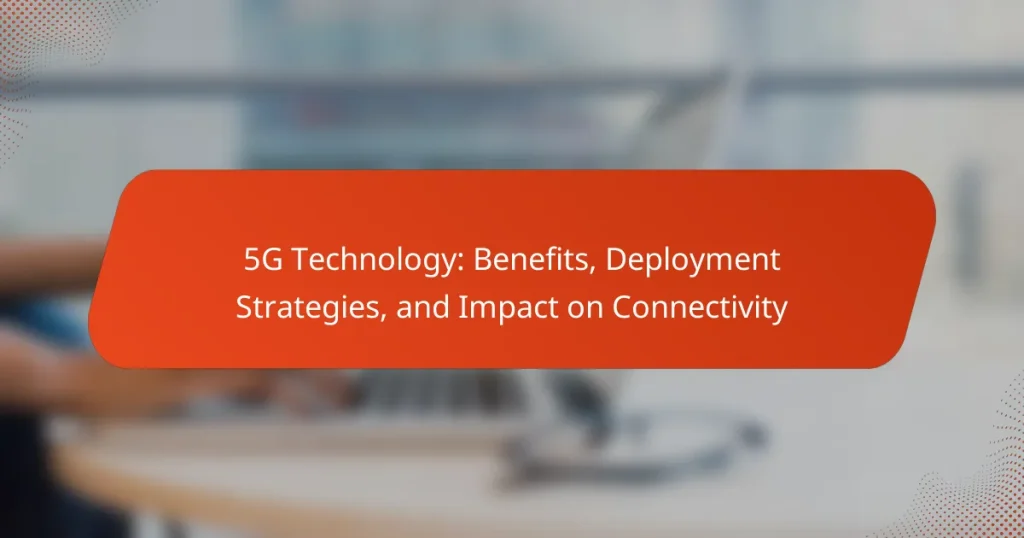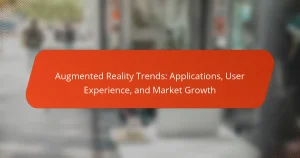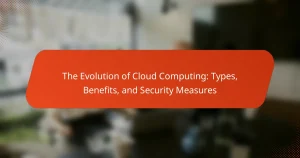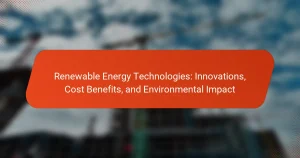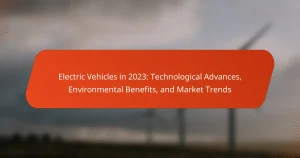5G technology represents the fifth generation of mobile network technology, providing data speeds of up to 10 Gbps and significantly lower latency, which enhances real-time communication. It supports a vast number of connected devices, facilitating the growth of the Internet of Things (IoT) and advancements in sectors such as telemedicine, smart cities, and autonomous vehicles. The article will explore various deployment strategies for 5G, including standalone and non-standalone architectures, small cell deployment, and network slicing, which are essential for optimizing connectivity in urban environments. Additionally, the anticipated growth of global 5G connections, projected to reach 1.7 billion by 2025, underscores the transformative impact of this technology on industries and connectivity.
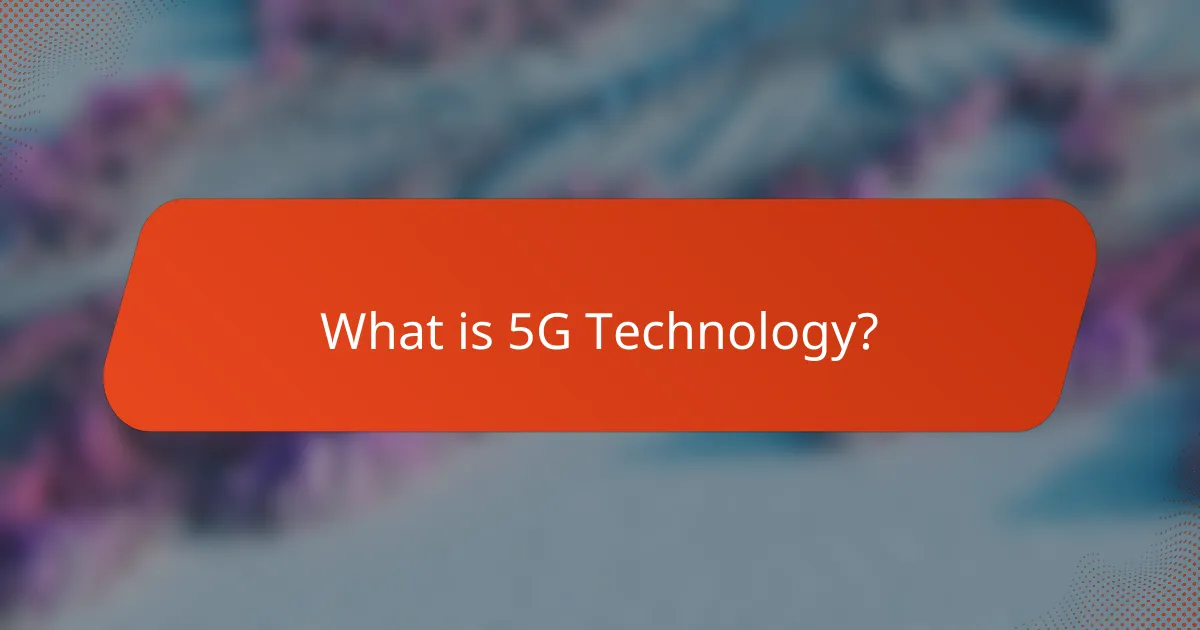
What is 5G Technology?
5G technology is the fifth generation of mobile network technology. It offers significantly faster data speeds compared to previous generations. 5G networks can achieve speeds up to 10 Gbps. This technology also provides lower latency, enhancing real-time communication. Additionally, 5G supports a larger number of connected devices simultaneously. It enables advancements in IoT, smart cities, and autonomous vehicles. The rollout of 5G is expected to transform various industries and improve connectivity.
How does 5G Technology differ from previous generations?
5G technology differs from previous generations primarily through its enhanced speed, capacity, and latency. It can achieve download speeds of up to 10 Gbps, significantly faster than 4G’s maximum of 1 Gbps. 5G networks support a larger number of connected devices per square kilometer, enabling up to 1 million devices compared to 4G’s 100,000.
Additionally, 5G technology reduces latency to as low as 1 millisecond, while 4G typically has a latency of around 30-50 milliseconds. This improvement allows for real-time applications such as autonomous vehicles and remote surgeries.
Moreover, 5G utilizes advanced technologies like millimeter waves, massive MIMO, and beamforming, which optimize signal quality and network efficiency. These features collectively enhance user experiences and support innovative applications that were not feasible with earlier generations.
What are the key technical specifications of 5G Technology?
5G technology has several key technical specifications. These include a peak data rate of up to 10 Gbps. The latency is reduced to as low as 1 millisecond. 5G supports a bandwidth of 100 MHz to 1 GHz. It can connect up to 1 million devices per square kilometer. The technology utilizes millimeter waves in the 24 GHz to 100 GHz frequency range. 5G networks are designed to provide enhanced mobile broadband services. They also support ultra-reliable low-latency communications. Finally, 5G enables massive machine-type communications for IoT applications.
How does the architecture of 5G enhance connectivity?
The architecture of 5G enhances connectivity through advanced technologies like massive MIMO and beamforming. Massive MIMO allows for multiple antennas to transmit and receive signals simultaneously. This increases the capacity and efficiency of the network. Beamforming directs signals toward specific users, reducing interference and improving signal quality.
Additionally, 5G employs a distributed network architecture. This architecture minimizes latency by processing data closer to the end user. The use of small cells further enhances coverage and capacity in densely populated areas.
According to the International Telecommunication Union, 5G can support up to one million devices per square kilometer. This high device density is crucial for IoT applications. Overall, the combination of these architectural features significantly boosts connectivity in various environments.
What are the core components of 5G Technology?
The core components of 5G technology include enhanced mobile broadband, ultra-reliable low latency communication, and massive machine-type communications. Enhanced mobile broadband provides faster data rates, enabling high-definition video streaming and immersive experiences. Ultra-reliable low latency communication ensures quick response times, crucial for applications like autonomous driving and remote surgery. Massive machine-type communications support a vast number of connected devices, facilitating the Internet of Things (IoT). These components work together to enhance connectivity, offering improved capacity and efficiency in wireless communication.
What role do antennas play in 5G Technology?
Antenna systems are crucial for 5G technology as they enable high-speed wireless communication. They facilitate the transmission and reception of radio signals between devices and networks. 5G utilizes multiple-input multiple-output (MIMO) technology, which employs numerous antennas to improve data throughput. This technology allows for simultaneous data streams, enhancing network capacity.
Antenna design in 5G includes small cells and beamforming techniques. Small cells increase coverage and capacity in dense urban areas. Beamforming directs signals toward specific users, reducing interference and improving efficiency.
The frequency bands used in 5G, particularly millimeter waves, require advanced antenna systems for effective propagation. These higher frequencies offer greater bandwidth but have shorter range, necessitating a denser network of antennas.
Overall, antennas are foundational to achieving the high performance and low latency promised by 5G technology.
How do network slicing and edge computing contribute to 5G?
Network slicing and edge computing significantly enhance 5G networks. Network slicing allows multiple virtual networks to operate on a single physical infrastructure. Each slice can be optimized for specific use cases, such as IoT or high-speed mobile broadband. This flexibility improves resource efficiency and user experience.
Edge computing complements this by processing data closer to the source. It reduces latency and bandwidth usage by minimizing the distance data must travel. This is crucial for applications requiring real-time responses, such as autonomous vehicles and remote surgery.
Together, network slicing and edge computing enable 5G to support diverse applications effectively. They provide tailored solutions that meet varying performance and reliability needs. These technologies are essential for realizing the full potential of 5G connectivity.
What are the potential applications of 5G Technology?
5G technology has several potential applications across various sectors. It enables enhanced mobile broadband for faster internet speeds. This supports activities like streaming high-definition video and online gaming. 5G also facilitates the Internet of Things (IoT), connecting numerous devices seamlessly. Smart cities can utilize 5G for efficient traffic management and public safety systems. In healthcare, remote surgeries and telemedicine become more viable with low latency. Manufacturing benefits from 5G through automation and real-time monitoring. Additionally, 5G supports augmented and virtual reality applications for immersive experiences. These applications demonstrate the transformative impact of 5G technology across industries.
How can 5G Technology transform industries like healthcare and transportation?
5G technology can significantly transform industries like healthcare and transportation. In healthcare, it enables real-time remote patient monitoring. This allows healthcare providers to track vital signs instantly. It enhances telemedicine services by providing high-definition video consultations. The low latency of 5G improves the reliability of robotic surgeries. In transportation, 5G facilitates vehicle-to-everything (V2X) communication. This technology improves traffic management and reduces accidents. Autonomous vehicles benefit from real-time data exchange for safer navigation. According to a report by the GSMA, 5G can reduce latency to as low as 1 millisecond. This rapid response time is crucial for both healthcare and transportation applications.
What innovations can 5G enable in smart cities?
5G technology can enable numerous innovations in smart cities. It enhances connectivity for IoT devices, allowing real-time data exchange. This leads to improved traffic management through smart traffic signals. 5G supports advanced public safety solutions, such as real-time surveillance and emergency response systems. It also facilitates smart energy grids, optimizing energy distribution and consumption. Additionally, 5G enables autonomous vehicles to communicate seamlessly with infrastructure. The technology supports augmented and virtual reality applications for urban planning and maintenance. According to a report by the GSMA, 5G can connect up to 1 million devices per square kilometer, significantly boosting urban efficiency.
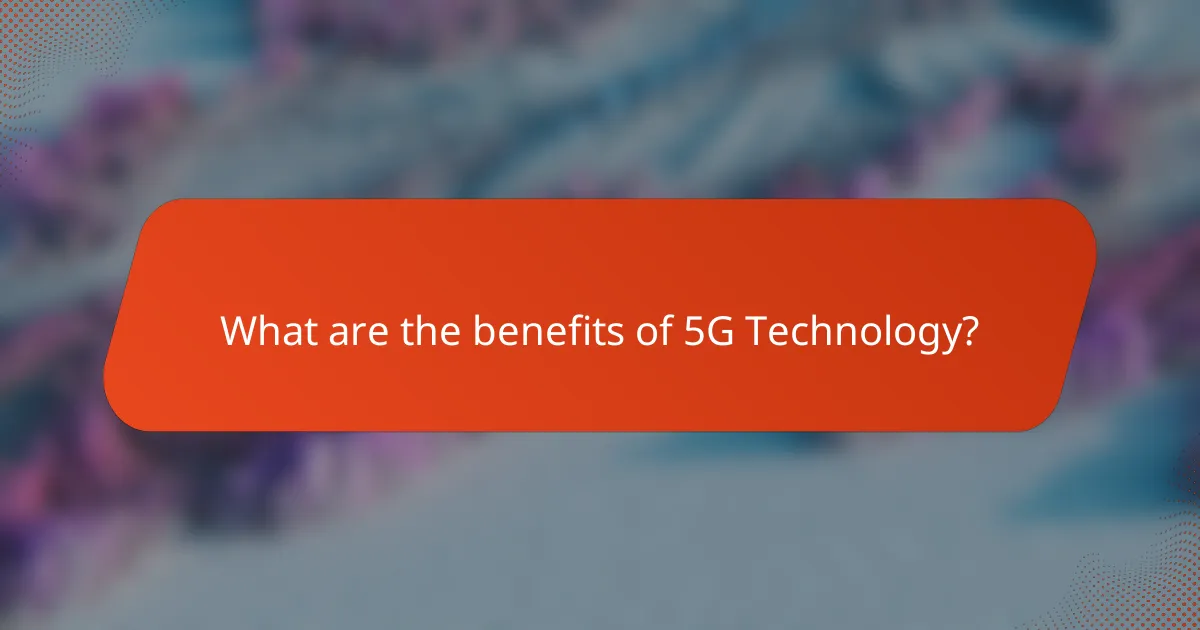
What are the benefits of 5G Technology?
5G technology offers significantly faster data speeds compared to previous generations. It can achieve speeds up to 10 Gbps. This enhanced speed enables quicker downloads and smoother streaming experiences. Additionally, 5G reduces latency to as low as 1 millisecond. This minimal delay is crucial for applications like online gaming and real-time communications.
Furthermore, 5G supports a greater number of connected devices simultaneously. It can connect up to 1 million devices per square kilometer. This capability is essential for the growth of the Internet of Things (IoT).
Moreover, 5G technology provides improved reliability and network efficiency. It has a higher capacity to handle network traffic without degradation. This leads to a more stable connection in densely populated areas.
Lastly, 5G facilitates advancements in various sectors. It enhances telemedicine, smart cities, and autonomous vehicles. These innovations can lead to significant improvements in quality of life and economic growth.
How does 5G Technology improve user experience?
5G technology improves user experience by offering faster data transfer speeds. It can achieve speeds up to 10 Gbps, significantly reducing download and upload times. This allows for seamless streaming of high-definition content. Latency is also reduced to as low as 1 millisecond, enhancing real-time applications like gaming and video calls. The increased capacity supports more connected devices simultaneously without degradation in performance. Enhanced reliability ensures consistent connectivity, even in crowded areas. These improvements lead to a more efficient and enjoyable user experience across various applications.
What are the speed and latency improvements with 5G?
5G technology significantly improves speed and latency compared to previous generations. It offers download speeds up to 10 Gbps, which is 100 times faster than 4G. This enhancement allows for quicker data transfer and better streaming experiences. Latency in 5G networks can be as low as 1 millisecond. In contrast, 4G latency typically ranges from 30 to 50 milliseconds. This reduction in latency enables real-time applications, such as remote surgery and autonomous vehicles. The combination of higher speeds and lower latency enhances overall user experience and connectivity.
How does 5G Technology support more connected devices?
5G technology supports more connected devices by significantly increasing network capacity. It can handle up to one million devices per square kilometer. This is achieved through advanced technologies like Massive MIMO and beamforming. Massive MIMO uses multiple antennas to improve signal quality and capacity. Beamforming directs signals to specific devices, reducing interference. The increased bandwidth of 5G also allows for faster data transmission. This enables devices to connect and communicate more efficiently. Overall, 5G’s architecture is designed to accommodate a vast number of simultaneous connections.
What economic benefits does 5G Technology bring?
5G technology brings significant economic benefits by enhancing productivity and enabling new business models. It is projected to contribute $13.2 trillion to the global economy by 2035. This technology facilitates faster data transfer and lower latency, which improves operational efficiency for industries. Sectors such as healthcare, manufacturing, and transportation are expected to see substantial gains. For example, telemedicine can thrive with reliable high-speed connections. The deployment of 5G also creates jobs in network infrastructure and related fields. Moreover, it fosters innovation by supporting the Internet of Things (IoT) and smart city initiatives. Enhanced connectivity can lead to increased consumer spending and improved quality of life, driving economic growth.
How can 5G Technology drive job creation and investment?
5G technology can drive job creation and investment by enabling new industries and enhancing existing ones. The rollout of 5G networks requires skilled labor for installation and maintenance. This creates jobs in telecommunications and related sectors. Additionally, 5G facilitates advancements in areas like IoT, autonomous vehicles, and smart cities. These innovations attract investment from businesses looking to leverage high-speed connectivity. According to a report by the GSMA, 5G could contribute $2.2 trillion to the global economy by 2034. This economic boost is likely to result in millions of new jobs across various sectors.
What is the expected impact of 5G on GDP growth?
5G is expected to significantly boost GDP growth. Research estimates indicate that 5G could contribute up to $13.2 trillion to the global economy by 2035. This growth stems from enhanced productivity and innovation across multiple sectors. Industries such as healthcare, transportation, and manufacturing will benefit from improved connectivity. Faster data transfer and lower latency will enable new applications and services. Additionally, 5G will facilitate advancements in automation and IoT technologies. These developments are projected to create millions of jobs globally. Overall, the economic impact of 5G is anticipated to be transformative.
What social benefits are associated with 5G Technology?
5G technology offers several social benefits, including enhanced connectivity and improved access to information. It enables faster internet speeds, allowing for seamless communication and collaboration. This technology supports the growth of smart cities, improving urban management and public services. Additionally, 5G facilitates remote work and education, making it easier for individuals to participate from various locations. It also promotes telemedicine, increasing access to healthcare services for underserved populations. Research indicates that 5G can significantly reduce latency, enhancing real-time applications like virtual reality and augmented reality. These advancements foster community engagement and innovation, ultimately contributing to economic growth and social development.
How can 5G Technology enhance education and remote work?
5G technology enhances education and remote work by providing faster internet speeds and lower latency. This results in improved online learning experiences and efficient remote collaboration. With speeds up to 10 Gbps, 5G supports high-definition video streaming and interactive content. Low latency, often below 1 millisecond, enables real-time communication and seamless virtual classrooms. Enhanced connectivity allows for the use of advanced tools like virtual reality in education. Remote workers benefit from stable connections, enabling smooth video conferencing and large file transfers. According to a study by Ericsson, 5G can increase productivity in remote work settings by up to 30%.
What role does 5G play in improving public safety and emergency response?
5G plays a crucial role in improving public safety and emergency response through enhanced communication and data transmission capabilities. The technology offers significantly lower latency, allowing real-time communication between first responders and command centers. This rapid data exchange enables quicker decision-making during emergencies. 5G supports a higher density of connected devices, facilitating the integration of IoT devices like drones and sensors in disaster scenarios. The increased bandwidth allows for high-definition video streaming, which can provide vital situational awareness to responders. Studies indicate that 5G can reduce response times by up to 30% in critical situations. Additionally, 5G networks are more resilient, ensuring communication remains operational during disasters when traditional networks may fail.
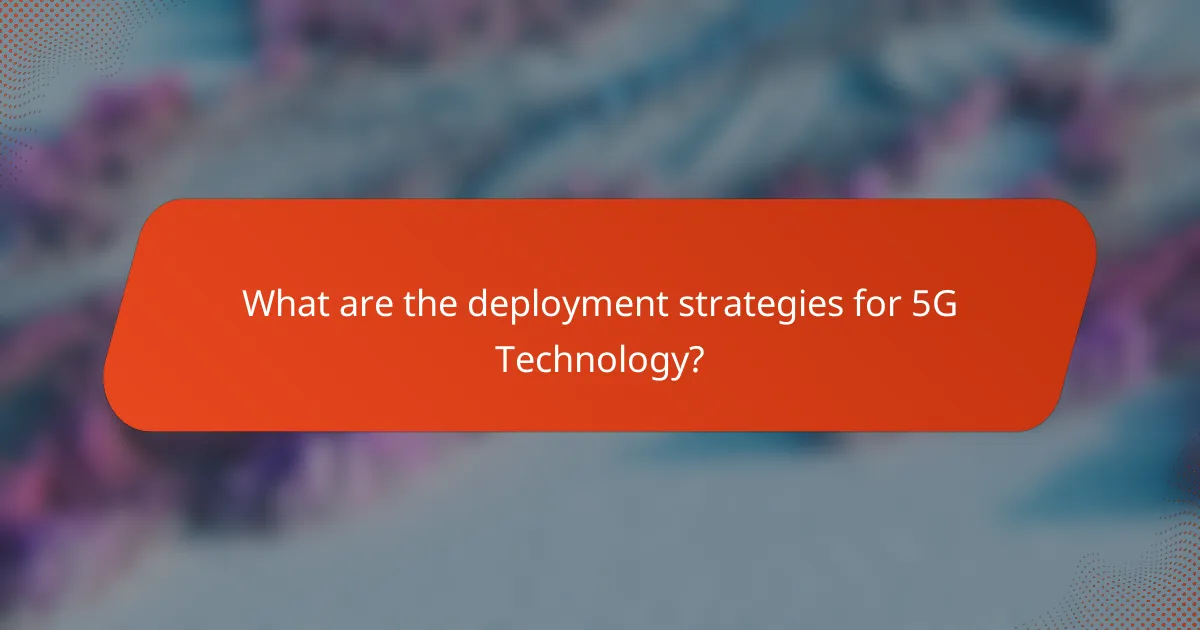
What are the deployment strategies for 5G Technology?
The deployment strategies for 5G technology include various approaches such as standalone (SA) and non-standalone (NSA) architectures. Standalone deployment operates independently, utilizing 5G core networks. Non-standalone deployment relies on existing 4G infrastructure for initial connectivity.
Another strategy involves small cell deployment, which enhances coverage and capacity in dense urban areas. Massive MIMO technology is also employed to improve spectral efficiency and user capacity. Network slicing allows for customized network experiences tailored to specific use cases.
These strategies are supported by industry standards and collaborations among telecommunications companies. According to the GSMA, global 5G connections are expected to reach 1.7 billion by 2025, reflecting the effectiveness of these deployment strategies.
How are telecom companies preparing for 5G rollout?
Telecom companies are preparing for 5G rollout by investing in infrastructure upgrades and spectrum acquisition. They are deploying small cells to enhance network coverage and capacity. Major telecom providers are also collaborating with technology partners for advanced network solutions. Trials and pilot programs are being conducted to test 5G technologies in real-world environments. Additionally, companies are focusing on securing necessary licenses and regulatory approvals. They are training staff to manage new technologies and customer service demands. According to the GSMA, global investment in 5G networks is projected to reach $1 trillion by 2025. This investment reflects the industry’s commitment to delivering faster and more reliable connectivity.
What are the challenges faced in deploying 5G infrastructure?
The challenges faced in deploying 5G infrastructure include high costs, regulatory hurdles, and technical complexities. High costs arise from the need for new equipment and extensive network upgrades. Regulatory hurdles involve obtaining necessary permits and complying with local laws. Technical complexities include managing the integration of different technologies and ensuring network reliability. Additionally, the need for dense infrastructure, such as more cell towers, complicates deployment. These factors collectively slow down the rollout of 5G networks globally.
How do partnerships and collaborations facilitate 5G deployment?
Partnerships and collaborations facilitate 5G deployment by pooling resources and expertise among various stakeholders. This collective effort accelerates infrastructure development, enabling faster rollout of 5G networks. Collaborations between telecom companies, technology providers, and local governments enhance regulatory compliance and streamline deployment processes. For instance, partnerships can lead to shared infrastructure, reducing costs and improving efficiency. Data from the GSMA indicates that strategic alliances can cut deployment time by up to 30%. Additionally, joint ventures can drive innovation, fostering the development of new technologies that support 5G. Such collaborative frameworks are essential for overcoming technical and logistical challenges in 5G implementation.
What are the regulatory considerations for 5G deployment?
Regulatory considerations for 5G deployment include spectrum allocation, safety standards, and infrastructure regulations. Spectrum allocation ensures that frequencies are available for 5G use without interference. Various regulatory bodies, such as the Federal Communications Commission (FCC) in the U.S., manage this process. Safety standards address potential health effects from electromagnetic exposure. Organizations like the International Commission on Non-Ionizing Radiation Protection (ICNIRP) provide guidelines in this area. Infrastructure regulations govern the installation of antennas and small cells. Local zoning laws and permitting processes can impact deployment timelines. Compliance with these regulations is essential for successful 5G rollout.
How do government policies impact the rollout of 5G Technology?
Government policies significantly impact the rollout of 5G technology. Regulations determine the allocation of spectrum, which is essential for 5G deployment. For instance, the Federal Communications Commission (FCC) in the United States streamlined spectrum auctions to facilitate faster access for telecom companies. Additionally, policies regarding infrastructure, such as zoning laws and permitting processes, affect the speed of 5G tower installations. In many regions, local governments have adopted policies to reduce bureaucratic hurdles for deploying small cell networks. Furthermore, public funding initiatives can support the expansion of 5G in underserved areas. A report from the International Telecommunication Union (ITU) highlights that countries with proactive government strategies see faster 5G adoption rates. Overall, supportive government policies can accelerate the deployment of 5G technology, enhancing connectivity and economic growth.
What are the spectrum allocation challenges for 5G?
Spectrum allocation challenges for 5G include limited availability, regulatory hurdles, and interference issues. The demand for higher frequencies increases competition among service providers. Many countries face delays in auctioning spectrum bands for 5G use. Regulatory bodies must balance commercial interests with public safety and existing services. Interference from adjacent frequency users can degrade 5G performance. Additionally, the need for harmonization across regions complicates global deployment. These challenges impact the speed and efficiency of 5G rollout and adoption.
What best practices can ensure successful 5G deployment?
Successful 5G deployment requires strategic planning and collaboration. Operators should conduct thorough site assessments to identify optimal locations for infrastructure. Engaging with local governments and communities fosters support and eases regulatory processes. Investing in robust backhaul solutions ensures adequate data transmission capabilities. Implementing advanced network management tools enhances performance and reliability. Training personnel on 5G technologies is crucial for effective operation and maintenance. Continuous monitoring and adaptation to user demands improve network efficiency. According to a report by the GSMA, effective collaboration among stakeholders significantly accelerates deployment timelines.
How can cities plan for 5G infrastructure integration?
Cities can plan for 5G infrastructure integration by developing a comprehensive strategy that addresses key components. This includes assessing current infrastructure and identifying gaps that need to be filled. Cities should collaborate with telecommunications companies to understand technical requirements. They must also create zoning regulations that facilitate the installation of small cells and other necessary equipment. Engaging with the community is essential to address concerns and gather support. Additionally, cities can leverage public-private partnerships to share costs and resources. According to a study by the GSMA, cities that adopt these strategies can significantly enhance connectivity and economic growth.
What strategies can businesses adopt to leverage 5G Technology effectively?
Businesses can adopt several strategies to leverage 5G technology effectively. First, they should invest in infrastructure upgrades to support 5G networks. This includes enhancing their existing hardware and software systems. Second, companies can develop applications that utilize the high-speed capabilities of 5G. These applications can improve customer engagement and operational efficiency. Third, businesses should focus on partnerships with telecom providers. Collaborating with these providers can facilitate smoother 5G integration. Fourth, organizations can implement data analytics tools. These tools can help analyze the vast amounts of data generated by 5G networks. Finally, training employees on new technologies is essential. This ensures that staff can maximize the benefits of 5G technology. According to a report by Ericsson, 5G can increase mobile data traffic by up to 1000 times, highlighting its potential impact on business operations.
What are the potential impacts of 5G Technology on connectivity?
5G technology significantly enhances connectivity by providing faster data speeds and lower latency. It can achieve download speeds of up to 10 Gbps, which is up to 100 times faster than 4G. This speed allows for smoother streaming and quicker downloads. Additionally, 5G technology reduces latency to as low as 1 millisecond. This improvement enables real-time communication for applications like remote surgery and autonomous vehicles. The increased capacity of 5G networks supports more devices simultaneously. This is crucial for the Internet of Things (IoT), where billions of devices will connect. Enhanced connectivity from 5G can drive innovations in smart cities and industrial automation. Overall, 5G technology transforms connectivity by making it faster, more reliable, and capable of supporting a broader range of applications.
How can users maximize their experience with 5G Technology?
Users can maximize their experience with 5G technology by ensuring they have compatible devices. Devices that support 5G can access faster speeds and lower latency. Users should also choose a service plan that offers 5G coverage. This ensures they can utilize the technology wherever available.
Staying in areas with strong 5G signals enhances connectivity. 5G networks are deployed in specific regions, so users should check coverage maps. Additionally, utilizing 5G-enabled applications can enhance the experience. These apps are designed to take advantage of 5G’s capabilities.
Finally, users should keep their devices updated. Regular updates can improve performance and security. According to a report by the GSMA, 5G can provide speeds up to 100 times faster than 4G. This demonstrates the significant benefits of fully utilizing 5G technology.
5G technology is the fifth generation of mobile network technology, offering significantly faster data speeds, lower latency, and the ability to connect up to one million devices per square kilometer. This article covers the key technical specifications of 5G, including its architecture, core components, and the role of antennas in enhancing connectivity. It also explores the transformative potential of 5G across various sectors such as healthcare, transportation, and smart cities, alongside the economic and social benefits associated with its deployment. Additionally, the article discusses the challenges and strategies involved in rolling out 5G infrastructure, including regulatory considerations and best practices for successful implementation.
